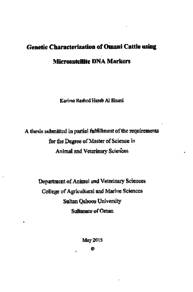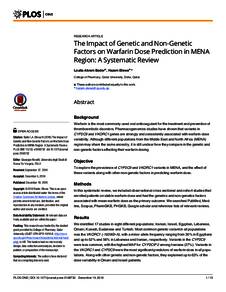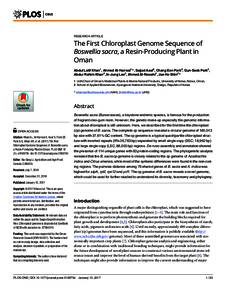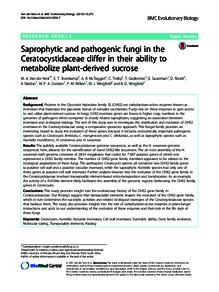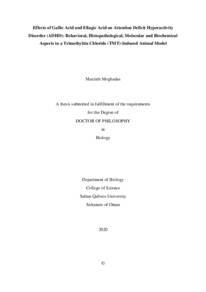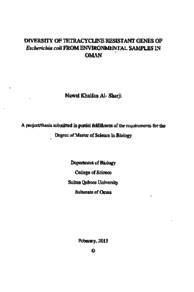وثيقة
Genetic characterization of Omani cattle using microsatellite DNA markers
الناشر
Sultan Qaboos University
ميلادي
2015
اللغة
الأنجليزية
الملخص الإنجليزي
The indigenous cattle breeds in Oman have special characteristics that are possibly not available for foreign breeds. They are highly preferred by consumers in Oman and they are more adapted to the harsh arid environment and prevailing diseases. A high level of cattle diversity serves the needs for designing breeding programs, increasing quality and productivity and improving gene selection programs. Because of the lack of information on genetic diversity of local cattle, the present study aimed to evaluate the genetic diversity and structure of cattle populations in Oman, using microsatellite markers. Two local Omani cattle breeds (Al-Batinah and Dhofari), two cattle breeds which are usually imported in the country (Ethiopian and Pakistani) and data generated for European breeds (Friesian, Jersey and Charolais) were included in the analyses. Blood samples were collected from 41 unrelated animals and the genomic DNA was extracted using QIAamp Blood Midi Kit. Şix microsatellite markers (recommended by the ISAG/FAO) were amplified by PCR using specified protocols. PCR products were run on agarose gel mixed with ethidium bromide then visualized under UV light. The size of microsatellite alleles were measured using 100 bp DNA ladder. Fragment analysis was carried out on ABI Prism genetic analyzer 3130. Microsatellite fragment sizing was done using the Gene Mapper program. A total of 74 alleles were distinguished by the six microsatellite primers used. The number of alleles detected per locus varied from 10 to 18, with an average of 12.3 alleles per locus. The average value for effective number of alleles over loci and population was 3.35. The level of gene diversity was high as indicated by the mean observed and expected heterozygosity values across all loci for all populations, which were 0.5890.053 and 0.719 +0.048, respectively. The mean value of polymorphic information content (PIC) was 0.815. There was a significant deviation from Hardy-Weinberg Equilibrium (HWE) at the six microsatellite loci for all populations. Significant linkage disequilibrium (p<0.05) was detected in the overall microsatellite data for 15 loci. Level of inbreeding (mean Fis = 0.098) was moderate. The coefficient of gene differentiation (Fst) and inbreeding for all population (Fit) were 0.194 and 0.271, respectively. The mean number of migrants between populations per generation (gene flow=Nm) across all breeds was 1.204. An analysis of molecular variance (AMOVA) of the seven populations' results exposed higher genetic diversity within populations compared to diversity among them. A PCOA analysis and an UPGMA cluster showed that Oman North, Oman South, Ethiopian and Pakistani breeds are clearly located far away from the three European breeds (Charolais, Friesian and Jersey). Also the two analyses revealed that Al-Batinah and Dhofari breeds are distinguished breeds and they show significant genetic diversity between them. Our results indicated that microsatellite markers used in the study were effective in distinguishing between cattle breeds and useful in differentiations between closely morphological related breeds. This study also emphasized the importance of monitoring genetic variability in local populations both for conservation purpose and to maintain breed identity and genetic diversity.
Keywords: genetic diversity, microsatellite, conservation, Omani cattle.
المجموعة
URL المصدر
الملخص العربي
تتميز سلالات الأبقار المحلية في سلطنة عمان بخصائص لا تتوفر في السلالات الأجنبية مثل تفضيل لحومها من قبل المستهلكين العمانيين وتكيفها مع الظروف البيئية المحلية القاسية و الأمراض المستوطنة. وجود مستوى عال من التنوع الحيوي في الأبقار العمانية يخدم الاحتياجات المختلفة لتصميم برامج التربية، و تحسين جودتها و رفع كفاءتها الإنتاجية والحفاظ عليها، ونظرا لعدم وجود معلومات كافية حول التنوع الوراثي للأبقار المحلية، هدفت هذه الدراسة إلى تقييم التنوع الوراثي ودراسة قطعان الأبقار في سلطنة عمان باستخدام الواسمات الوراثية. شمل هذا البحث اثنين من سلالات الأبقار المحلية العمانية المعروفة (الباطنة والظفاري)، واثنين من سلالات الأبقار التي عادة ما يتم استيرادها إلى السلطنة (الأثيوبية والباكستانية)، كما تم ادراج بيانات لبعض السلالات الأوروبية وتضم الفريزيان و الجيرسي والشارولي ، لمقارنتها مع الأبقار المحلية. تم جمع 41 عينة دم من الأبقار غير ذات صلة الوراثية في ما بينها من مختلف مناطق السلطنة. وبعدها تم استخلاص الحمض النووي الجيني باستخدام QIAamp Blood Midi Kit. تم تضخيم الحمض النووي عن طريق اجراء تفاعل البلمرة التسلسلي باستخدام ستة من الواسمات الجزيئية "الميكروساتلايت" الموصى بها من قبل منظمة الزراعة والأغذية للأمم المتحدة ( ISAG / FAO ). تم التاكد من نجاح تفاعل البلمرة عن طريق استخدام هلام الأجاروز وتصويره تحت الأشعة فوق البنفسجية. تم قياس حجم الأليلات باستخدام الحمض النووي المدرج (bp DNA ladder100). وتم التحليل الوراثي باستخدام جهاز 3130 ABI Prism genetic analyzer و تم الحصول على البيانات باستخدام برنامج Gene Mapper . كان العدد الكلي للأليلات المشاهدة للست واسمات في السبع سلالات 74 أليل ، و تفاوت عدد الأليلات المكشوفة في كل موضع من 10 إلى 18 أليل ، بمتوسط 12. 3 . وكان متوسط قيمة العدد الفعلي للأليلات 3 . 35. و أشارت النتائج الى وجود مستوى عال من التنوع الجيني الوراثي ، وقد لوحظ ذلك من خلال متوسط التغاير الوراثي (heterozygosity المشاهد والمتوقع عبر كل مواضع الجينات لجميع القطعان 0 . 589 + 0. 0530 . 719 + 0 . 048 على التوالي. وبلغت متوسط قيمة محتوى المعلومات متعدد الاشكال ال(PIC) 0 . 815 . كان هناك انحراف عن قانون هاردي واوينبيرج (HWE) في الست واسمات في جميع القطعان. تم الكشف عن اختلال الترابط بصورة كبيره (P < 005) في 15 موضع . كان مستوى التزاوج الداخلي (Fis = 0 . 098) معتدلا. وكان معامل التمييز الجيني في السلالات (Fst) والتزاوج الداخلي للقطعان (Fit) يساوي 0. . 194 و 0 . 271 على التوالي. وكان متوسط الهجرة بين السلالات في الجيل يساوي 1. 204. واوضح تحليل التباين الجزيني (AMOVA) وجود تنوع وراثي كبير داخل السلالات مقارنة بالتنوع في ما بينها. وأظهر تحليل PCoA وكتلة UPGMA أن سلالات ابقار الباطنة والظفاري و الأثيوبي والباكستاني تقع بوضوح بعيدة عن السلالات الأوروبية الثلاث (الشارولي والفريزيان والجيرسي). كما كشفت هذه التحليلات أن سلالتي الأبقار العمانية "الباطنة والظفاري" سلالتان مختلفتان، و ويوجد بينهما تنوع حيوي واضح. أشارت نتائج هذه الدراسة إلى أن الواسمات الوراثية المستخدمة في هذا البحث كانت فعالة للتمييز بين سلالات الأبقار وحتى بين تلك السلالات التي تحمل صفات شكلية متقاربة جدا. وتؤكد هذه الدراسة أيضا على أهمية رصد التنوع الجيني في السلالات المحلية على حد سواء من اجل صيانتها والحفاظ عليها من الانجراف الوراثي.
قالب العنصر
الرسائل والأطروحات الجامعية

